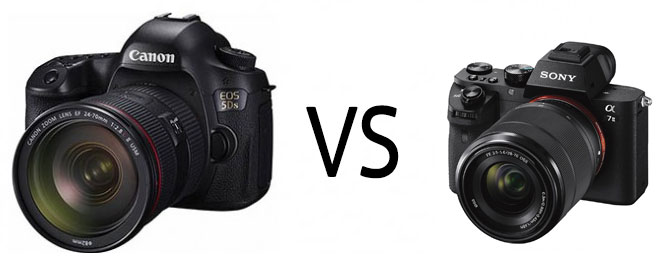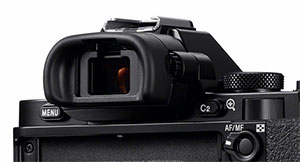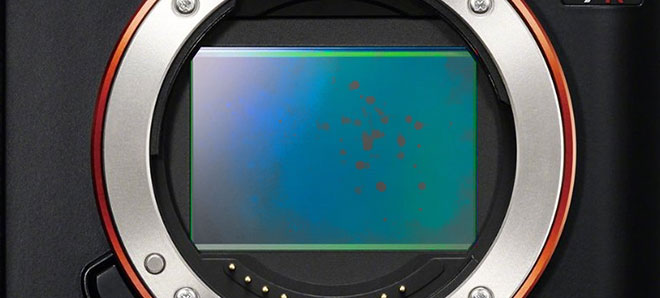
DSLR vs Mirrorless

With all the hype about mirrorless cameras, the marketplace is something of a minefield for new camera buyers, making it more difficult to decide which format they should invest in. When it comes to DSLR vs Mirrorless it’s best to consider what the differences are.
I shoot with both Canon DSLR and Sony mirrorless cameras. I can appreciate the advantages of both.
I decided to compile a list of Pros and Cons for you to consider. I’d also love to get your opinion and comments by offering this easy little poll right here. Just click on the one you prefer and please leave a comment below with your thoughts and opinions.
DSLR – Pros
- Bigger batteries give longer battery life
- More rugged build quality
- Wider selection of native lenses
- Mirror mechanism adds protection for sensor so less cleaning is required
DSLR – Cons
- Bigger
- Heavier
- Mirror needs locking up if you want ultra sharpness
- Mirror mechanism makes them louder
- Big gear can make you look intimidating for travel and street shooting
Mirrorless – Pros
- Smaller due to no mirror mechanism
- Lighter
- Typically quieter
- Smaller gear makes you look less intimidating
Mirrorless – Cons
- Pathetic battery life
- Less robust build quality
- Sensor needs cleaning more often
- Less native lens choices so extra money needs to be spent on adapters
Optical View Finder vs Electronic View Finder
 I specifically didn’t add this to the Pros and Cons list because this is something of a personal preference and both formats have their good points.
I specifically didn’t add this to the Pros and Cons list because this is something of a personal preference and both formats have their good points.
One of the things I love about DSLR is the optical viewfinder. As an outdoor photography there are often times when I compose a shot and then I have to wait for the light to change.
With DSLR I can switch off my camera and still keep looking through the viewfinder to judge the right time to start shooting.
If I want to do that with a mirrorless camera, it has to be switched on and using that feeble battery.
On the plus side of the EVF, I really love the ability to punch in and magnify what the camera is seeing so that I can focus even in bright sunlight.
When the quality of those EVF displays gets better, it’ll be the only way you’ll ever want to focus. Right now the quality is kind of poor but I reckon in two or three years it’ll be excellent.
Sensor Cleaning Demands of Mirrorless
Ever since I started using mirrorless cameras, I’ve had to get used to the fact that I need to clean those sensors way more often than with DSLR cameras.
That clunky mirror mechanism in DSLR cameras actually adds a lot of protection for your sensor because the sensor is not exposed to the elements as much as with mirrorless cameras.
Even if dust gets on the mirror of the DSLR, it’s easily shaken off during the super quick mechanical slap that happens when you take a picture. Using a good blower in the mirror chamber of your DSLR is often all that’s needed to keep things clean and dust free.
What’s Your Take?
Which do you own and why do you prefer one particular format over the other. Please leave a comment below with your thoughts.


For landscape photography do you think non full frame has ads engage with the ability to zoom 1.6 more distance or is the resolution so much better with full frame. I am using a canon 7D and have several nice lenses for the same but soon will want to upgrade.
Thanks
I think it doesn’t really matter Mark. If you’ve got full frame and lenses with enough reach that would give you more resolution for sure but I’ve seen enough amazing images from MFT and APS-C cameras that I don’t believe either one has an edge over the other unless you need mega res for prints.
I love my DSLRs (D750 and D7000), but the mirrorless offerings have been very interesting. I think as you said Gavin, give the technology 2-3 years to mature and get more lenses available, and it could be my next investment. For me, before I bought the D750 I was looking at the Sony, but the big killer for me was battery life and AF performance.
I hear you Vanessa. Stick with your DSLR until the mirrorless get more refined. Then us the Nikon as a cool second.
I’ve been weighing this up for a while now and reading the articles from users of both. I’ve really only just abandoned Pentax K1000s due to age (yes, film) and have gone full-time with Canon DSLR for all the best reasons (as I see them). But when I review my options in two to three years I suspect mirrorless is going to be very hard to ignore as best option – e.g. batteries that recharge in less than a minute (which implies vastly increased capacity not far away) and I suspect that most top end manufacturers will be mainstreaming mirrorless by then and will have found a way of dealing with the sensor hygiene problem. I think the rest will be history because the lens is the thing and they’ll have sorted that as well by then. But. And it’s a big but; there’ll always be a place for medium/large format cameras. Photography is still such an exciting thing to be part of.
Well said Tookie.
It’s getting harder and harder to decide. Nowadays I’ve been doing mostly street photography and I do struggle with the weight of my camera (Canon 60D). Plus people get really intimidated as soon as they see my camera so I need to pretend I’m photographing something elsewhere.
We also have a Sony A6000 at home, which has a very good grip (most of the mirrorless cameras don’t have a good grip) which offers the possibility of using only the viewfinder. It does save a lot of battery. The other thing is, if you like to use vintage lenses with the mirrorless is a lot easier to ensure focus. Good tip around the sensor, I hadn’t thought about that to be honest! I still love my canon, because I can achieve really good quality photos and love the quality of the raws – not the same with the mirrorless so far. Hopefully technology will keep on moving and it will be easier to find really good mirrorless cameras, or lighter DSLRs
It’s a tough comparative with no right or wrong answer IMO.
I am an amateur but do have extensive experience with both systems. I have a few full-frame Canon bodies (1Ds III, 5D III) and the Sony a7r. (I did own the Fuji X-T1 but sold it as I didn’t care for the qulaity of the RAW files.) I do more landscape photography now but used to do a lot of event photography. When I first started using the Mirrorless cameras, I was so impressed that I thought I would sell all my Canon DSLR gear; but, I’m glad I waited before I did that. I am thinking now that I will keep both systems as they have their relative strengths and weaknesses.
The mirrorless design is still in evolution but it definitely has some advantages in terms of viewfinder WSIWG. You can truly preview the exposure and DOF of your images before you hit the shutter. For methodical work on a tripod, manual focus is definitely easier and more accurate with the mirrorless system; especially with a tilt-shift lens. Having a tilting screen allows for lower placement of the camera etc.
The Sony body with adapters allows for the use of many lens systems including fantastic old lenses for quite unique effects… e.g. the Minolta 58mm/1.2 or some of the old Canon FD lenses render lovely images. The Sony sensor has a better Dynamic range than my Canon bodies and the files it produces are much more malleable in post processing; although that is not a function of the mirrorless design, the easy adaptability of these bodies allows a Canon user access to a better high resolution sensor to exploit the excellence of some of that great Canon glass. (I know, the 5Ds is coming.)
OTOH, I personally still prefer the handling and responsiveness of my DSLR’s over the Sony. The batteries last way longer and the the shutter responsiveness and AF inspires confidence in a way that the Sony never does. (The a7r has a ridiculously loud, high impact shutter. This may reflect the unrefined nature of the technology but it does affect the aesthetic and sharpness of some images.)
With Landscapes, despite the better DR and resolution of the Sony sensor, I find that the Canon files of the same scene occasionally have a slightly nicer aesthetic and sometimes have me choosing those over the Sony files. ( I am comparing RAW files.) This is variable but it is this difficult to define subjective quality that has me still invested in the Canon system.
For fast-moving subjects, birding or nature photography or any event stuff, the mirrorless can’t replace the DSLR’s. Off the grid, where one has limited access to power, the battery life issue has mirrorless in a distinct disadvantage.
I suspect we like to polarize these issues into black and white but the reality is not so clear-cut. Until the mirrorless systems mature more, I think there is room for both in a landscape photographer’s bag of tricks.
-evan
Great comments Evan. I’ve still yet to see a RAW file from my Canons that matches the Sony A7R but I expect that’ll change when the 5Ds gets tested. Also, a lot depends on your lens choice. As I mentioned in my A7R Review, the old Canon 24-105mm excels on the A7R in a way it never could on the Canon cameras I used. I’ve found the autofocus on the A6000 to be excellent when using native Sony lenses but I don’t shoot birds so I can’t comment on how will it handles that.
Oops.
Just read your review of the a7r & realize I’m just repeating much of what you said, more eloquently already. My apologies.
-evan
I am a serious amateur photographer. I recently purchased a Sony A7S , not for video but for low light indoor photography. I totally agree regarding battery life and AF. But there are other very critical aspects to consider. When I use it with my Zeiss 55 F1.8, it weighs abut the same as a D750 body. . I can use it all day. The flip screen is extremely useful, the focus peeking, silent shutter along with range of other features. We live in a digital world and the fact I can upload my photos during a shoot through the inbuilt wifi to my IPAD and present it instantaneously on facebook etc is brilliant. That is what everyone does with their IPHONES.
I also do a lot of landscape photography. I was talking to a professional photographer while visiting New Zealand and all he carries with him is his XPAN, + 2 lenses and a small tripod – less then 2-3 kg.He only needs a small bag. Here I am lugging a huge amount of weight on my back . As for lens choices, the new range of zeiss lenses coming out this year will address many of the gaps . At the moment I will watch and wait to see how mirrorless camera’s evolve but I think this is an exciting development. Technology is moving very fast, just look at the advances of the EVF.
Thanks Anthony. I’ve gone from despising EVF to loving it. Once they’ve begun to offer higher resolution on those EVFs it will be the preferred choice as you’ll never have to guess about perfect focus.
Nice help to the shopping of my new camera.Thanks